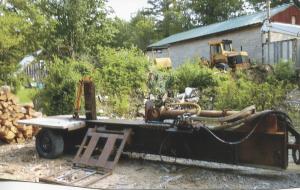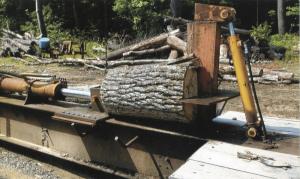Semi Truck Powers Wood Splitter
“It’s not pretty but it splits wood fast and handles the biggest logs you can find,” says George Young, Jr., Westminster, Mass., about the massive wood splitter he and his friend Joseph Morin built. It’s powered by a 300 hp Mack semi truck.
The giant splitter is operated by a 47 gpm hydraulic pump that’s powered by the semi truck’s pto. A crane mounts on back of the semi truck and is powered by a smaller pump that operates off a double chain drive system, with a small double sprocket on the small pump and a larger double sprocket on the pto shaft. The crane has 3 boom sections and operates a hydraulic winch with 100 ft. of cable for pulling logs to the splitter table.
The entire setup mounts on a pair of welded-together 2 1/2-ft. wide, 1/2-in. thick H-beams off an old railroad trestle, and is supported by an axle and wheels on back. Threaded rod is welded onto the 2 beams at various places as a safety precaution. “There are nuts on the tie rod so if the 2 beams get loose or start to bend I can just tighten the nuts up,” says Young.
The splitter’s 3-ft. tall splitting wedge is welded to a 1/2-in. thick steel sleeve that fits down into an 8 by 8-in. hole cut all the way down through the splitter table.
The wedge attaches to a hydraulic cylinder that’s used to raise or lower it up to 25 in., depending on the size of the log.
“I can pin 3 different cutters onto the sleeve. The cutters split the log into 2, 4, or 6 pieces. As a result, no matter the log’s size I can always put the cross in the middle of the log and split it into equal pieces. I never have to pick up any big pieces and split them again,” says Young.
“I run the push plate forward up to the wedge, and then I extend the cylinder on back of the wedge. The wedge pushes back on the top part of the log, while the push plate pushes forward on the bottom so splitting pressure is increased.
“The wedge is designed to withstand 20,000 lbs. of pressure, so no matter how hard the wood is the wedge won’t bend or break. I haven’t found a log that it won’t split,” he says. “Friends have brought over pieces of tough wood such as elm, oak, ironwood and maple they thought would be too much for my splitter to handle, but it handles them with no problem. And if the wedge ever did bend or break, I could quickly replace it since it’s not welded onto the table.”
“The truck’s engine is pretty fuel efficient and burns only about 1 gal. of fuel per hour, so we could do 10 cords of wood on 5 gal. of fuel.”
The splitter’s push plate is driven by a 3-ft. long piston off a Hough 100 front-end loader and is hydraulically adjustable to produce 4 or 6 equal size pieces of wood.
The splitter uses 6,000-lb. hydraulic pressure hoses. As a safety precaution, Young installed fire hoses over all the hoses. “If a line burst with that much pressure it would cut a person’s skin. If a hose breaks inside the fire hose it will catch the oil so it won’t be a problem.”
The crane is bolted to a steel plate that Young mounted on the semi truck’s frame.
The splitter is operated by 4 spool valves off a Prentice self-loading log loader. The valves are used to operate log-loading racks on both sides of the splitter, to raise or lower the wedge, and to operate the push plate.
Young says he spent a total of about $2,500. “I already had most of the parts that I used or got them from friends,” he notes.
Contact: FARM SHOW Followup, George Young, Jr., 19 Fred Smith Rd., Westminster, Ma. 01473 (ph 978 424-8094).

Click here to download page story appeared in.
Click here to read entire issue
Semi Truck Powers Wood Splitter TRUCKS Miscellaneous “It’s not pretty but it splits wood fast and handles the biggest logs you can find ” says George Young Jr Westminster Mass about the massive wood splitter he and his friend Joseph Morin built It’s powered by a 300 hp Mack semi truck The giant splitter is operated by a 47 gpm hydraulic pump that’s powered by the semi truck’s pto A crane mounts on back of the semi truck and is powered by a smaller pump that operates off a double chain drive system with a small double sprocket on the small pump and a larger double sprocket on the pto shaft The crane has 3 boom sections and operates a hydraulic winch with 100 ft of cable for pulling logs to the splitter table The entire setup mounts on a pair of welded-together 2 1/2-ft wide 1/2-in thick H-beams off an old railroad trestle and is supported by an axle and wheels on back Threaded rod is welded onto the 2 beams at various places as a safety precaution “There are nuts on the tie rod so if the 2 beams get loose or start to bend I can just tighten the nuts up ” says Young The splitter’s 3-ft tall splitting wedge is welded to a 1/2-in thick steel sleeve that fits down into an 8 by 8-in hole cut all the way down through the splitter table The wedge attaches to a hydraulic cylinder that’s used to raise or lower it up to 25 in depending on the size of the log “I can pin 3 different cutters onto the sleeve The cutters split the log into 2 4 or 6 pieces As a result no matter the log’s size I can always put the cross in the middle of the log and split it into equal pieces I never have to pick up any big pieces and split them again ” says Young “I run the push plate forward up to the wedge and then I extend the cylinder on back of the wedge The wedge pushes back on the top part of the log while the push plate pushes forward on the bottom so splitting pressure is increased “The wedge is designed to withstand 20 000 lbs of pressure so no matter how hard the wood is the wedge won’t bend or break I haven’t found a log that it won’t split ” he says “Friends have brought over pieces of tough wood such as elm oak ironwood and maple they thought would be too much for my splitter to handle but it handles them with no problem And if the wedge ever did bend or break I could quickly replace it since it’s not welded onto the table ” “The truck’s engine is pretty fuel efficient and burns only about 1 gal of fuel per hour so we could do 10 cords of wood on 5 gal of fuel ” The splitter’s push plate is driven by a 3-ft long piston off a Hough 100 front-end loader and is hydraulically adjustable to produce 4 or 6 equal size pieces of wood The splitter uses 6 000-lb hydraulic pressure hoses As a safety precaution Young installed fire hoses over all the hoses “If a line burst with that much pressure it would cut a person’s skin If a hose breaks inside the fire hose it will catch the oil so it won’t be a problem ” The crane is bolted to a steel plate that Young mounted on the semi truck’s frame The splitter is operated by 4 spool valves off a Prentice self-loading log loader The valves are used to operate log-loading racks on both sides of the splitter to raise or lower the wedge and to operate the push plate Young says he spent a total of about $2 500 “I already had most of the parts that I used or got them from friends ” he notes Contact: FARM SHOW Followup George Young Jr 19 Fred Smith Rd Westminster Ma 01473 ph 978 424-8094








